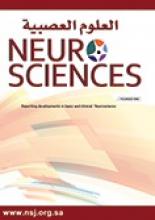Research ArticleOriginal Article
Open Access
Systematic review of the epidemiology of attention deficit hyperactivity disorder in Arab countries
Najla J. Alhraiwil, Anna Ali, Mowafa S. Househ, Ali M. Al-Shehri and Ashraf A. El-Metwally
Neurosciences Journal April 2015, 20 (2) 137-144; DOI: https://doi.org/10.17712/nsj.2015.2.20140678
Najla J. Alhraiwil
From the College of Public Health and Health Informatics (Alhraiwil, Ali, Al-Shehri, Househ, El-Metwally), King Saud Bin Abdulaziz University for Health Sciences, Riyadh, Kingdom of Saudi Arabia, and from the Institute of Applied Health Sciences (El-Metwally), University of Aberdeen, Aberdeen, Scotland, United Kingdom
BSc, MPHAnna Ali
From the College of Public Health and Health Informatics (Alhraiwil, Ali, Al-Shehri, Househ, El-Metwally), King Saud Bin Abdulaziz University for Health Sciences, Riyadh, Kingdom of Saudi Arabia, and from the Institute of Applied Health Sciences (El-Metwally), University of Aberdeen, Aberdeen, Scotland, United Kingdom
BDS, MScMowafa S. Househ
From the College of Public Health and Health Informatics (Alhraiwil, Ali, Al-Shehri, Househ, El-Metwally), King Saud Bin Abdulaziz University for Health Sciences, Riyadh, Kingdom of Saudi Arabia, and from the Institute of Applied Health Sciences (El-Metwally), University of Aberdeen, Aberdeen, Scotland, United Kingdom
PhDAli M. Al-Shehri
From the College of Public Health and Health Informatics (Alhraiwil, Ali, Al-Shehri, Househ, El-Metwally), King Saud Bin Abdulaziz University for Health Sciences, Riyadh, Kingdom of Saudi Arabia, and from the Institute of Applied Health Sciences (El-Metwally), University of Aberdeen, Aberdeen, Scotland, United Kingdom
MD, MFPHAshraf A. El-Metwally
From the College of Public Health and Health Informatics (Alhraiwil, Ali, Al-Shehri, Househ, El-Metwally), King Saud Bin Abdulaziz University for Health Sciences, Riyadh, Kingdom of Saudi Arabia, and from the Institute of Applied Health Sciences (El-Metwally), University of Aberdeen, Aberdeen, Scotland, United Kingdom
MD, PhD
References
- ↵
- Childress AC,
- Berry SA
- ↵
- Barkley RA
- ↵
- Richa S,
- Rohayem J,
- Chammai R,
- Kazour F,
- Haddad R,
- Hleis S,
- et al.
- ↵
- Bener A,
- Qahtani RA,
- Abdelaal I
- ↵
- Polanczyk G,
- Rohde LA
- ↵
- Bener A,
- Al Qahtani R,
- Teebi AS,
- Bessisso M
- ↵
- Visser SN,
- Danielson ML,
- Bitsko RH,
- Holbrook JR,
- Kogan MD,
- Ghandour RM,
- et al.
- ↵
- Agency for Healthcare Research and Quality. Attention-Deficit/Hyperactivity Disorder, Diagnosis;
- ↵
- Reiff MI,
- Stein MT
- ↵
- Faraone SV,
- Biederman J,
- Spencer T,
- Wilens T,
- Seidman LJ,
- Mick E,
- et al.
- ↵
- Plomin R,
- DeFries JC,
- McClearn GE,
- McGuffin P
- ↵
- Willcutt E
- ↵
- Brassett-Harknett A,
- Butler N
- ↵
- Millichap JG
- ↵
- Farah LG,
- Fayyad JA,
- Eapen V,
- Cassir Y,
- Salamoun MM,
- Tabet CC,
- et al.
- ↵
- Alqahtani MM
- ↵
- Jenahi E,
- Khalil MS,
- Bella H
- ↵
- Attia M,
- Tayel K,
- Mounier G,
- Ahmed M,
- Abo-Rass N
- ↵
- Al Hamed JH,
- Taha AZ,
- Sabra AA,
- Bella H
- ↵
- El Koumi MA,
- Ali YF,
- El Banna EA,
- Youssef UM,
- Raya YM,
- Ismail AA
- ↵
- Yehia MA,
- Afify MF,
- Soliman GT
- ↵
- Eapen V,
- al-Gazali L,
- Bin-Othman S,
- Abou-Saleh M
- ↵
- Eapen V,
- Jakka ME,
- Abou-Saleh MT
- ↵
- Eapen V,
- Al-Sabosy M,
- Saeed M,
- Sabri S
- ↵
- Eapen V,
- Mabrouk AA,
- Zoubeidi T,
- Sabri S,
- Yousef S,
- Al-Ketbi J,
- et al.
- ↵
- Al-Karagully TS
- ↵
- Suhail HJ
- ↵
- Ashor AW
- Bener A,
- Qahtani RA,
- Abdelaal I
- ↵
- Bener A,
- Al Qahtani R,
- Teebi AS,
- Bessisso M
- ↵
- Bener A,
- Kamal M
- ↵
- Miller T,
- el-Masri M,
- Allodi F,
- Qouta S
- ↵
- Al-Sharbati M,
- Al-Adawi S,
- Ganguly S,
- Al-Lawatiya S,
- Al-Mshefri F
- ↵
- Alyahri A,
- Goodman R
- ↵
- Khemakhem K,
- Yaich S,
- Ayedi H,
- Walha A,
- Moalla Y,
- Damak J,
- et al.
- Nafi OA
- ↵
- Richa S,
- Rohayem J,
- Chammai R,
- Kazour F,
- Haddad R,
- Hleis S,
- et al.
- ↵
- Barkley R
- ↵
- Gillberg C,
- Gillberg IC,
- Rasmussen P,
- Kadesjö B,
- Söderström H,
- Råstam M,
- et al.
- Levy F,
- Hay DA,
- Bennett KS,
- McStephen M
- ↵
- Biederman J
- ↵
- Okasha A,
- cMaj M
- Fayyad J,
- Sadek M,
- Cordahi C
- ↵
- Farah LG,
- Fayyad JA,
- Eapen V,
- Cassir Y,
- Salamoun MM,
- Tabet CC,
- et al.
- ↵
- Fayyad J,
- De Graaf R,
- Kessler R,
- Alonso J,
- Angermeyer M,
- Demyttenaere K,
- et al.
- ↵
- Spencer TJ,
- Faraone SV,
- Tarko L,
- McDermott K,
- Biederman J
In this issue
Systematic review of the epidemiology of attention deficit hyperactivity disorder in Arab countries
Najla J. Alhraiwil, Anna Ali, Mowafa S. Househ, Ali M. Al-Shehri, Ashraf A. El-Metwally
Neurosciences Journal Apr 2015, 20 (2) 137-144; DOI: 10.17712/nsj.2015.2.20140678
Jump to section
Related Articles
- No related articles found.
Cited By...
- No citing articles found.





